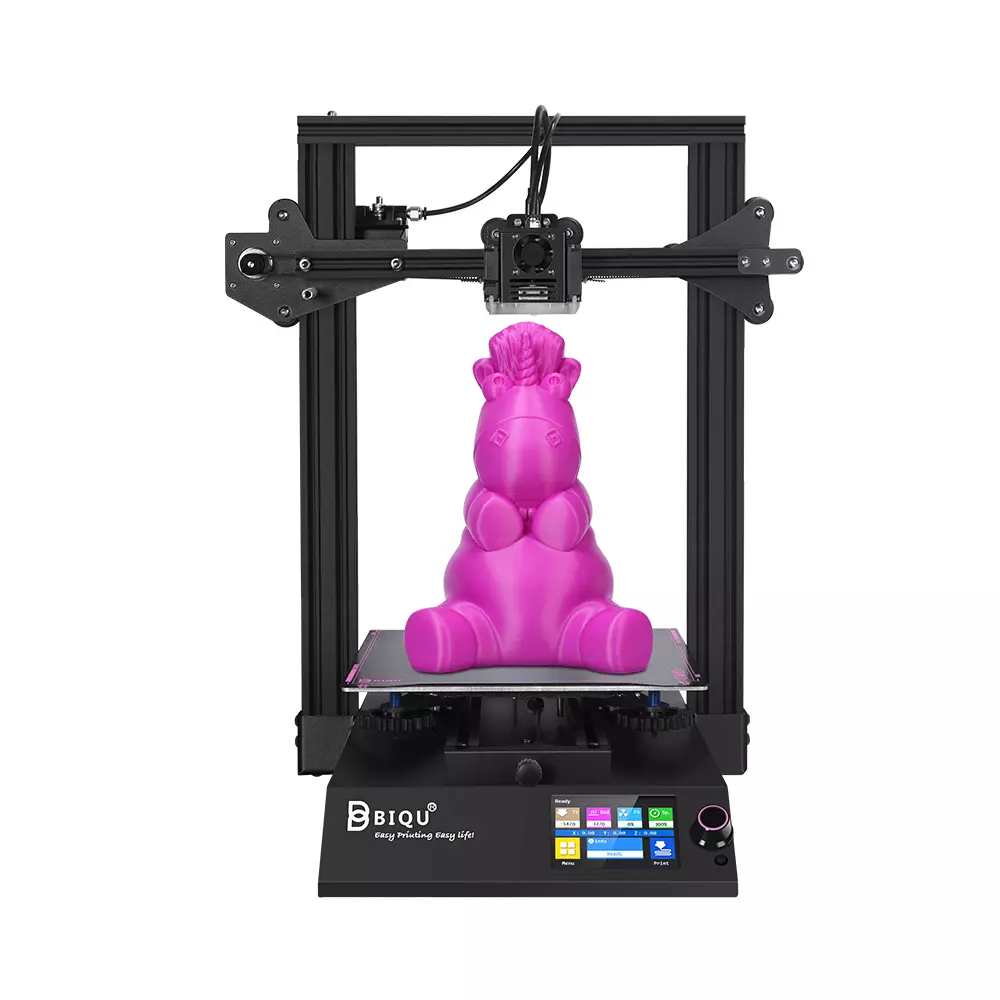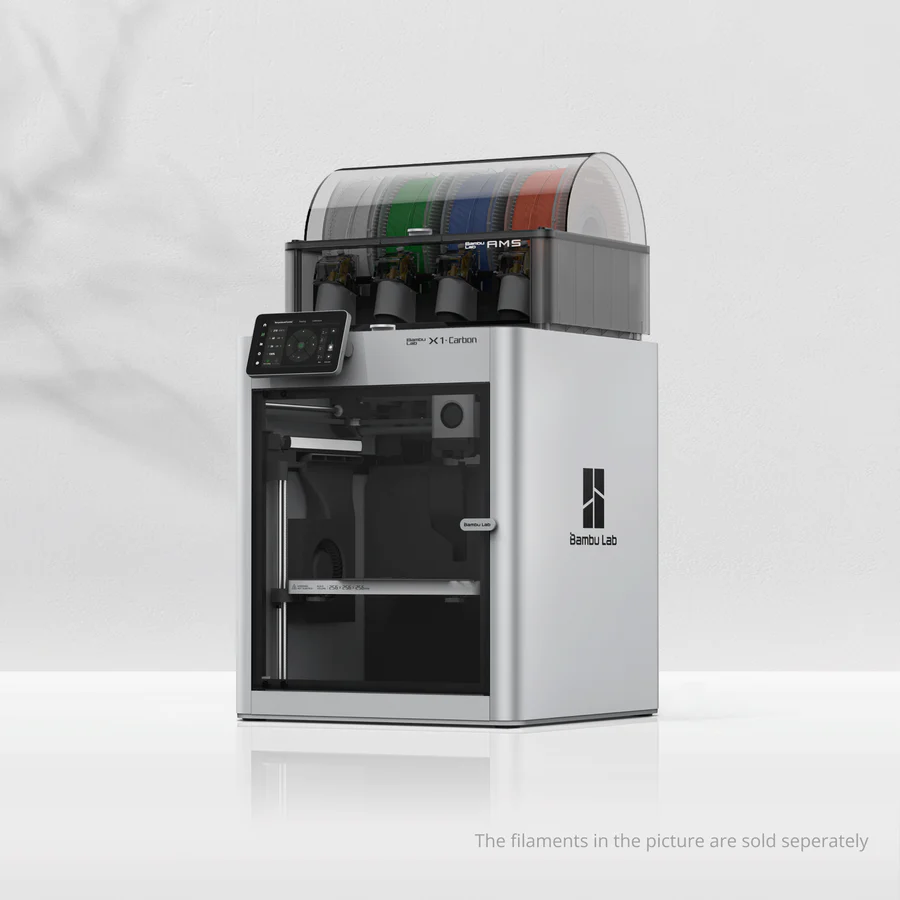Compare BIQU B1 vs X1 carbon
Comparison between the best 3D printers
Choose the best 3D printer at the best price. The cheapest 3D printers are here.
Buy a 3D printer here with 3D Fila.
 |
 |
|
| Model | BIQU B1 |
X1 carbon |
| Printing Material | Filament | Filament |
| Buy Filament for BigTreeTech BIQU B1 | Buy Filament forBambu Lab X1 carbon | |
| Estimated price | $269,00 | $1449,00 |
| Manufacturer | BigTreeTech | Bambu Lab |
| Release Year | 2020 | 2023 |
| Print Volume [mm] | 235x235x270 | 256x256x256 |
| Printer Size [mm] | 412x402x492 | 389x389x457 |
| Weight [kg] | 8,00 | 14,13 |
| Power Loss Recovery | YES | YES |
| Enclosed printer | NO | YES |
| Bed Leveling | Manual | Automatic |
| Filament End Sensor | YES | YES |
| Bed type | Heated | Heated |
| Power supply system | Bowden | Direct Drive |
| Standard nozzle | 0,4 | 0,4 |
| Maximum Nozzle Temperature [°C] | 250 | 300 |
| Maximum Bed Temperature [°C] | 100 | 120 |
| Maximum printing speed [mm/s] | 100 | 500 |
| Filament holder | YES | YES |
| Camera for supervision | NO | NO |
| Recommended filaments | PLA, TPU, ABS, PETG | PLA, PETG, TPU, PVA, PA, PA-CF, Nylon, PC |
| Recommended slicers | Cura, Simplify, Slic3r | Bambu Studio, Super Slicer, Cura, Prusa Slicer, Orca |
| Maximum Resolution [mm] | 0,1 | 0,1 |
| Processor | 32 Bits BTT SKR V 1.4 | Quad ARM A7 1.2 GHz |
| Display | Touchscreen TFT 3,5'' | Touchscreen 5'' |
| Power Supply | 24V / 360W | 350 W |
| Connectivity | SD / USB | Wifi, Bambu bus, Cartão SD |
| Operating systems | Windows, Mac, Linux | Windows, Linux, Macbook |
| Date of registration in the system | 2021-04-14 | 2024-04-10 |
| Release date | 2020 | 2023 |
| Extra features | The BIQU B1 is an advanced 3D printer with a silent 32-bit BTT SKR V1.4 motherboard and ARM Cortex-M3 CPU, offering DIY interfaces (I2C, SPI, WiFi) and dual Z-axis. Its dual BTT B1 TFT35 V3.0 operating system allows real-time monitoring and multiple printing modes, including G-code visualization effects. It stands out for its BIQU SSS (Super Spring Steel), ensuring easy model adhesion and simplified removal, with the possibility of using it on both sides. It includes a filament sensor, automatically pausing printing in case of filament breakage. The multicolored RGB lights integrated into the hotend allow you to view the printing status even at night. Additional notes include the need for a BIQU-specific Type-C cable and extra interfaces for smart filament sensor and BL Touch. | The Bambu Lab X1 Carbon revolutionizes 3D printing with stunning design, high print speeds, and a streamlined user experience. It stands out with its CoreXY system, a hotend capable of reaching 300°C, allowing for a wide range of filaments. Its LiDAR-assisted bed leveling system, vibration compensation, and AMS multicolor printing capability raise the industry standard. Print quality is impressive, with the ability to fine-tune for perfection. The X1 Carbon, with its closed build volume, not only promises but also delivers one of the most advanced 3D printing experiences available to consumers. |
| Support for multiple colors and materials (AMS and CFS) | NO | YES |
Notes * |
||
| Cost-benefit | 7 / 10 | 7 / 10 |
| Hardware | 2 / 10 | 6.4 / 10 |
| Tela | . | . |
| Print volume | 3 / 10 | 4 / 10 |
| Performance | 1 / 10 | 4 / 10 |
Conclusion |
| In conclusion, when comparing the BIQU B1 and the Bambu Lab X1 Carbon 3D printers, several key differences emerge that cater to different user needs and budgets. The BIQU B1 is a cost-effective option suitable for hobbyists and those entering the world of 3D printing. With its manual bed leveling and standard features such as a heated bed and a filament end sensor, it offers a solid foundation for basic printing needs. Its lighter build and smaller print volume also make it more portable, while its lower maximum printing speed reflects its more basic capabilities. On the other hand, the Bambu Lab X1 Carbon is a high-end printer designed for professionals and enthusiasts who demand superior performance and versatility. Its advanced features, including automatic bed leveling, a direct drive system, and higher maximum temperatures, allow it to support a wider range of materials and achieve faster print speeds. The closed design enhances safety and print quality, while its cutting-edge technology provides a more streamlined user experience. Ultimately, the choice between the two will largely depend on individual requirements and budget considerations. For those seeking an affordable entry-level printer with essential features, the BIQU B1 is an excellent choice. Conversely, for users willing to invest more for advanced capabilities and higher performance, the Bambu Lab X1 Carbon stands out as a top-tier option in the current market. |

